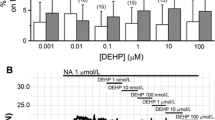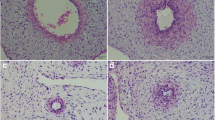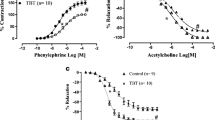Abstract
Bisphenol A (BPA) is an endocrine-disrupting chemical widely used in the plastics industry, including food container, toys, and medical equipment. We analyzed the effect of BPA in human umbilical artery contractility and expression of some proteins modulating this function, such as ionic channels and proteins involved in the cGMP pathway. Using standard organ bath technique, rings of human umbilical arteries without endothelium were contracted by 5-HT (1 μM) and histamine (10 μM) and the effect of different concentrations of BPA (1 nM–100 μM) was analyzed. The results showed that BPA is a vasodilator of these arteries in a concentration-dependent way. Besides, qPCR studies on human umbilical smooth muscle cells (HUSMC) allowed to analyze the effects of BPA on gene expression. Thus, 12-h exposition to BPA induced reduction of expression of L-type calcium channels (LTCC), alpha subunit of BKCa channels, and Kvβ1 and Kvβ3 from Kv channels. BPA also decreased the expression of soluble guanylate cyclase (sGC) and natriuretic peptide receptor type A (NPRA), meanwhile increasing that of PKG, proteins involved in vasodilation of human umbilical arteries (HUA) by cGMP. Further studies will be necessary to increase knowledge about the implications of these changes induced by BPA exposure.
Graphical Abstract







Similar content being viewed by others
Data availability
The authors of the manuscript did not consider it necessary to use research data support to make available data and materials related to the submitted manuscript. However, the datasets generated during and/or analyzed during the current study are available from the corresponding author on reasonable request.
Change history
20 December 2022
A Correction to this paper has been published: https://doi.org/10.1007/s11356-022-24808-6
Abbreviations
- sGC:
-
Soluble guanylate cyclase
- PKG:
-
Protein kinase dependent on cGMP
- Cav1.2:
-
Subunit of L-type calcium channels
- NPRA:
-
Natriuretic peptide receptor A
- BKCaα:
-
α Subunit of calcium activated potassium channels
- BKCaβ:
-
β Subunit of calcium activated potassium channels
- Kvβ1:
-
β1 Subunit of voltage-dependent potassium channels
- Kvβ2:
-
β2 Subunit of voltage-dependent potassium channels
- Kvβ3:
-
β3 Subunit of voltage-dependent potassium channels
References
Acharya G, Sonesson SE, Flo K, Rasanen J, Odibo A (2016) Hemodynamic aspects of normal human feto-placental (umbilical) circulation. Acta Obstet Gynecol Scand 95:672–682. https://doi.org/10.1111/aogs.12919
Alonso-Magdalena P, Ropero AB, Soriano S, Garcia-Arevalo M, Ripoll C, Fuentes E, Quesada I, Nadal A (2012) Bisphenol-A acts as a potent estrogen via non-classical estrogen triggered pathways. Mol Cell Endocrinol 355:201–207. https://doi.org/10.1016/j.mce.2011.12.012
Asano S, Tune JD, Dick GM (2010) Bisphenol A activates Maxi-K (K(Ca)1.1) channels in coronary smooth muscle. Br J Pharmacol 160:160–170. https://doi.org/10.1111/j.1476-5381.2010.00687.x
Bae S, Kim JH, Lim YH, Park HY, Hong YC (2012) Associations of bisphenol A exposure with heart rate variability and blood pressure. Hypertension 60:786–793. https://doi.org/10.1161/HYPERTENSIONAHA.112.197715
Barberio L, Paulesu L, Canesi L, Grasselli E, Mandala M (2021) Bisphenol a interferes with uterine artery features and impairs rat feto-placental growth. Int J Mol Sci 22:6912. https://doi.org/10.3390/ijms22136912
Belfort MA, Saade GR, Suresh M, Johnson D, Vedernikov YP (1995) Human umbilical vessels: responses to agents frequently used in obstetric patients. Am J Obstet Gynecol 172:1395–1403
Bosselmann S, Mielke G (2015) Sonographic assessment of the umbilical cord. Geburtshilfe Frauenheilkd 75:808–818. https://doi.org/10.1055/s-0035-1557819
Boura AL, Walters WA, Read MA, Leitch IM (1994) Autacoids and control of human placental blood flow. Clin Exp Pharmacol Physiol 21:737–748
Cairrao E, Santos-Silva AJ, Alvarez E, Correia I, Verde I (2009) Isolation and culture of human umbilical artery smooth muscle cells expressing functional calcium channels. In Vitro Cell Dev Biol Anim 45:175–184
Cairrao E, Santos-Silva AJ, Verde I (2010) PKG is involved in testosterone-induced vasorelaxation of human umbilical artery. Eur J Pharmacol 640:94–101
Diamanti-Kandarakis E, Bourguignon JP, Giudice LC, Hauser R, Prins GS, Soto AM, Zoeller RT, Gore AC (2009) Endocrine-disrupting chemicals: an Endocrine Society scientific statement. Endocr Rev 30:293–342. https://doi.org/10.1210/er.2009-0002
Firth AL, Remillard CV, Platoshyn O, Fantozzi I, Ko EA, Yuan JX (2011) Functional ion channels in human pulmonary artery smooth muscle cells: voltage-dependent cation channels. Pulm Circ 1:48–71. https://doi.org/10.4103/2045-8932.78103
Gao X, Liang Q, Chen Y, Wang HS (2013) Molecular mechanisms underlying the rapid arrhythmogenic action of bisphenol A in female rat hearts. Endocrinol 154:4607–4617. https://doi.org/10.1210/en.2013-1737
Gao X, Ma J, Chen Y, Wang HS (2015) Rapid responses and mechanism of action for low-dose bisphenol S on ex vivo rat hearts and isolated myocytes: evidence of female-specific proarrhythmic effects. Environ Health Perspect 123:571–578. https://doi.org/10.1289/ehp.1408679
Ghatta S, Nimmagadda D, Xu X, O’Rourke ST (2006) Large-conductance, calcium-activated potassium channels: structural and functional implications. Pharmacol Ther 110:103–116
Gore AC, Chappell VA, Fenton SE, Flaws JA, Nadal A, Prins GS, Toppari J, Zoeller RT (2015) Executive summary to EDC-2: the Endocrine Society’s second scientific statement on endocrine-disrupting chemicals. Endocr Rev 36:593–602. https://doi.org/10.1210/er.2015-1093
Guntur D, Olschewski H, Enyedi P, Csáki R, Olschewski A, Nagaraj C (2021) Revisiting the large-conductance calcium-activated potassium (BKCa) channels in the pulmonary circulation. Biomolecules 11:1629. https://doi.org/10.3390/biom11111629
Jackson WF (2018) KV channels and the regulation of vascular smooth muscle tone. Microcirculation 25:e12421. https://doi.org/10.1111/micc.12421
Jaggar JH, Porter VA, Lederer WJ, Nelson MT (2000) Calcium sparks in smooth muscle. Am J Physiol Cell Physiol 278:C235-256
Korovkina VP, England SK (2002) Detection and implications of potassium channel alterations. Vascul Pharmacol 38:3–12
Kukreja RC (2017) Myriad roles of voltage-activated potassium channel subunit Kvbeta1.1 in the heart. Am J Physiol Heart Circ Physiol 312:H546–H548. https://doi.org/10.1152/ajpheart.00005.2017
Lang IA, Galloway TS, Scarlett A, Henley WE, Depledge M, Wallace RB, Melzer D (2008) Association of urinary bisphenol A concentration with medical disorders and laboratory abnormalities in adults. J Am Med Assoc 300:1303–1310. https://doi.org/10.1001/jama.300.11.1303
Mak KK, Gude NM, Walters WA, Boura AL (1984) Effects of vasoactive autacoids on the human umbilical-fetal placental vasculature. Br J Obstet Gynaecol 91:99–106
Matuszczak E, Komarowska MD, Debek W, Hermanowicz A (2019) The impact of bisphenol A on fertility, reproductive system, and development: a review of the literature. Int J Endocrinol 2019:4068717. https://doi.org/10.1155/2019/4068717
Melzer D, Rice NE, Lewis C, Henley WE, Galloway TS (2010) Association of urinary bisphenol a concentration with heart disease: evidence from NHANES 2003/06. PLoS ONE 5:e8673. https://doi.org/10.1371/journal.pone.0008673
Michaela P, Maria K, Silvia H, L’Ubica L (2013) Bisphenol A differently inhibits CaV3.1, Ca V3.2 and Ca V3.3 calcium channels. Naunyn Schmiedebergs Arch Pharmacol 387:153–163. https://doi.org/10.1007/s00210-013-0932-6
Moon S, Yu SH, Lee CB, Park YJ, Yoo HJ, Kim DS (2021) Effects of bisphenol A on cardiovascular disease: an epidemiological study using National Health and Nutrition Examination Survey 2003–2016 and meta-analysis. Sci Total Environ 763:142941. https://doi.org/10.1016/j.scitotenv.2020.142941
Morgado M, Cairrao E, Santos-Silva AJ, Verde I (2012) Cyclic nucleotide-dependent relaxation pathways in vascular smooth muscle. Cell Mol Life Sci 69:247–266. https://doi.org/10.1007/s00018-011-0815-2
Pfaffl MW (2001) A new mathematical model for relative quantification in real-time RT-PCR. Nucleic Acids Res 29:e45
Posnack NG (2014) The adverse cardiac effects of Di(2-ethylhexyl)phthalate and bisphenol A. Cardiovasc Toxicol 14:339–357. https://doi.org/10.1007/s12012-014-9258-y
Rottgen TS, Fancher IS, Asano S, Widlanski TS, Dick GM (2014) Bisphenol A activates BK channels through effects on alpha and beta1 subunits. Channels (austin) 8:249–257
Santos-Silva AJ, Cairrao E, Verde I (2010) Study of the mechanisms regulating human umbilical artery contractility. Health 2:321–331. https://doi.org/10.4236/health.2010.24049
Saura M, Marquez S, Reventun P, Olea-Herrero N, Arenas MI, Moreno-Gomez-Toledano R, Gomez-Parrizas M, Munoz-Moreno C, Gonzalez-Santander M, Zaragoza C, Bosch RJ (2014) Oral administration of bisphenol A induces high blood pressure through angiotensin II/CaMKII-dependent uncoupling of eNOS. FASEB J 28:4719–4728. https://doi.org/10.1096/fj.14-252460
Shankar A, Teppala S, Sabanayagam C (2012) Bisphenol A and peripheral arterial disease: results from the NHANES. Environ Health Perspect 120:1297–1300. https://doi.org/10.1289/ehp.1104114
Vandenberg LN, Chahoud I, Heindel JJ, Padmanabhan V, Paumgartten FJ, Schoenfelder G (2010) Urinary, circulating, and tissue biomonitoring studies indicate widespread exposure to bisphenol A. Environ Health Perspect 118:1055–1070. https://doi.org/10.1289/ehp.0901716
Yan S, Chen Y, Dong M, Song W, Belcher SM, Wang HS (2011) Bisphenol A and 17beta-estradiol promote arrhythmia in the female heart via alteration of calcium handling. PLoS ONE 6:e25455. https://doi.org/10.1371/journal.pone.0025455
Acknowledgements
The authors would like to thank the donor mothers and the staff of the Gynaecology–Obstetrics Department of the “Centro Hospitalar da Cova da Beira” (Covilhã, Portugal) for their collaboration.
Funding
This work is supported by FEDER funds through the POCI-COMPETE 2020-Operational Programme Competitiveness and Internationalisation in Axis I-Strengthening research, technological development and innovation (Project POCI-01–0145-FEDER-007491) and National Funds by FCT-Foundation for Science and Technology (Project UID/Multi/00709/2013).
Author information
Authors and Affiliations
Contributions
All authors whose names appear on the submission:
(1) made substantial contributions to the conception or design of the work; or the acquisition, analysis, or interpretation of data; or the creation of new software used in the work
(2) drafted the work or revised it critically for important intellectual content
(3) approved the version to be published
(4) agree to be accountable for all aspects of the work in ensuring that questions related to the accuracy or integrity of any part of the work are appropriately investigated and resolved
Nádia Oliveira contributed to the data curation, formal analysis, investigation, methodology, resources, validation, visualization, writing original draft, writing, review, and editing.
Helena Marcelino contributed to the formal analysis, investigation, methodology, resources, supervision, writing, review, and editing.
Regina Azevedo contributed to the formal analysis, investigation, methodology, resources, supervision, writing, review, and editing.
Ignacio Verde contributed to the conceptualization, data curation, formal analysis, funding acquisition, investigation, methodology, project administration, software, supervision, visualization, writing original draft, writing, review, and editing.
Corresponding author
Ethics declarations
Ethics approval and consent to participate
All procedures performed with umbilical cord samples were approved by the Ethics Committee of “Centro Hospitalar da Cova da Beira” (Covilhã, Portugal) according to Declaration of Helsinki guidelines. The umbilical cord pieces were collected at “Centro Hospitalar da Cova da Beira” (Covilhã, Portugal) from normal term pregnancies after vaginal delivery. According with the report of the Ethics Committee, the anonymity of the mothers/newborns was assured. In addition, to use the umbilical cord samples, the informed consent of the donner mothers was settled.
Consent for publication
All listed authors have read the manuscript and approved its submission to Environmental Science and Pollution Research: Nadia Oliveira, Helena Marcelino, Regina Azevedo, and Ignacio Verde.
Competing interests
The authors declare no competing interests.
Additional information
Responsible editor: Ludek Blaha
Publisher's note
Springer Nature remains neutral with regard to jurisdictional claims in published maps and institutional affiliations.
The original online version of this article was revised: Prof. Elisa Cairrão does not want to be acknowledged in this article. The statement is removed in the Acknowledgement section.
Rights and permissions
Springer Nature or its licensor (e.g. a society or other partner) holds exclusive rights to this article under a publishing agreement with the author(s) or other rightsholder(s); author self-archiving of the accepted manuscript version of this article is solely governed by the terms of such publishing agreement and applicable law.
About this article
Cite this article
Oliveira, N., Marcelino, H., Azevedo, R. et al. Effects of bisphenol A on human umbilical arteries. Environ Sci Pollut Res 30, 27670–27681 (2023). https://doi.org/10.1007/s11356-022-24069-3
Received:
Accepted:
Published:
Issue Date:
DOI: https://doi.org/10.1007/s11356-022-24069-3




